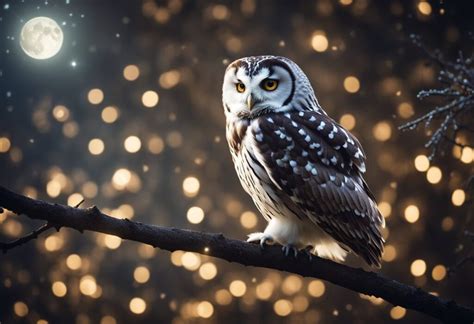Beyond Eerie Calls: A World of Communication
Owls, with their piercing eyes and distinctive calls, have fascinated humans for centuries. Their haunting hoots, often associated with mystery and wisdom, hold a wealth of information for those who understand their language.

Types of Owl Hoots
The variety of owl hooting sounds is as diverse as the species themselves. Here are some common types:
- Territorial hooting: Owls use these low-pitched, repetitive calls to establish and defend their territories. They often hoot from perches or while soaring above their hunting grounds.
- Contact calls: Short, high-pitched hoots are used by pairs or groups of owls to maintain contact and coordinate their activities.
- Courtship calls: Owls use unique, complex hoots during courtship to attract mates. These calls vary in rhythm and pitch and can be extremely loud.
- Distress calls: Owls make high-pitched, frantic hoots when threatened or alarmed. These calls serve to alert other owls or deter potential predators.
- Hunger calls: Owlets often hoot when hungry, signaling to their parents the need for food.
Interpreting Owl Hoots
While owl hoots differ in sound and purpose, there are general patterns that can help us understand their meaning:
- Pitch: Higher-pitched hoots generally indicate alarm or distress, while lower-pitched hoots are associated with territorial defense or contact.
- Volume: Loud hoots are often used to convey an urgent message or to establish dominance over a larger area.
- Repetition: Repetitive hoots suggest that the owl is feeling threatened or territorial.
- Timing: Owls may hoot more frequently during mating season or when defending their nests.
Owl Hoot Meaning Examples
Here are some specific examples of owl hooting meanings:
- A barred owl’s long, drawn-out “who-cooks-for-you” call is a territorial hoot used to establish its presence in an area.
- A great horned owl’s deep, resonant “hoo-hoo-hoo” is a contact call used to maintain contact with its mate.
- A barn owl’s high-pitched, screeching “screech” is a courtship call used to attract potential mates.
- A snowy owl’s sharp, piercing “hiss” is a distress call used when threatened by predators.
The Significance of Owl Hoots for Nature
Owl hoots play a crucial role in maintaining the delicate balance of ecosystems. These calls help owls establish territories, attract mates, defend their young, and communicate with other owls. By understanding the meaning of owl hoots, we gain valuable insights into the behavior and ecology of these fascinating creatures.
Owl Hoot Meaning in Culture
Throughout history, owl hoots have held deep cultural significance in many human societies.
- In ancient Greece, owls were associated with the goddess Athena, the patron of wisdom and warfare.
- In some Native American cultures, owls are considered spiritual guides, symbolizing wisdom and knowledge.
- In parts of Asia, owls are believed to have supernatural powers and are often associated with good luck or misfortune.
Creative Applications of Owl Hoot Meaning
The rich meaning behind owl hoots has inspired various creative applications:
- Bioacoustics: Scientists use owl hoot recordings to study owl behavior, monitor populations, and identify different species.
- Owl language apps: Mobile applications allow users to identify and interpret owl hoots based on their sound characteristics.
- Nature documentaries: Documentaries and films often incorporate owl hoots to evoke a sense of mystery and wonder in viewers.
Useful Tables on Owl Hoot Types
| Owl Species | Hoot Type | Meaning |
|---|---|---|
| Great Horned Owl | Deep, resonant “hoo-hoo-hoo” | Contact call |
| Barred Owl | Long, drawn-out “who-cooks-for-you” | Territorial hoot |
| Barn Owl | High-pitched, screeching “screech” | Courtship call |
| Snowy Owl | Sharp, piercing “hiss” | Distress call |
Effective Strategies for Interpreting Owl Hoots
- Identify the species: Different owl species have distinctive hoots. Determine the species by comparing the sound to recordings or online databases.
- Consider the context: Observe the owl’s behavior and surroundings to provide context for its hoots.
- Listen for patterns: Pay attention to the pitch, volume, repetition, and timing of the hoots.
- Educate yourself: Read books, articles, and listen to owl calls to enhance your understanding of their language.
Tips and Tricks for Owl Hoot Observation
- Use a flashlight with a red filter to avoid disturbing owls.
- Maintain a respectful distance and avoid making loud noises.
- Visit owl habitats at twilight or nighttime when owls are most active.
- Record owl hoots using a digital recorder or smartphone app for later analysis.
Common Mistakes to Avoid
- Misinterpreting the species: Hoots can vary within species, so be careful not to make assumptions based solely on a single recording.
- Attributing human emotions: Owls do not experience emotions like humans. Their hoots are solely for communication purposes.
- Disturbing owls: Respect owl habitats and avoid approaching them too closely.
- Overlooking the context: Consider the owl’s behavior and surroundings to fully understand the meaning of its hoots.
Conclusion
Owl hoots are a captivating and enigmatic part of the natural world. By understanding the meaning behind these haunting calls, we can appreciate the complex communication and behavior of owls. From territorial defense to attracting mates, owl hoots serve a vital role in maintaining the balance of ecosystems and inspiring our imaginations.
